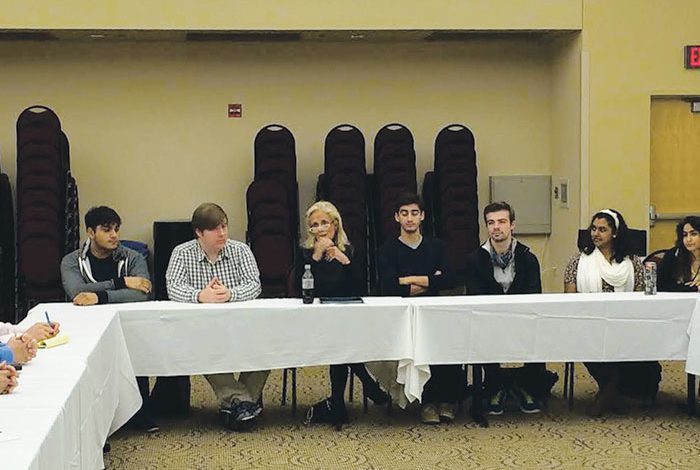
|
| Administrators and democratic nominee for Congress Debbie Dingell discuss student loan debts at a panel hosted by UM-D. |
DEARBORN — In recent years, student loan debt has prevailed as a major issue at both the state and national levels.
This week, the Arab Student Union and Student Government at the University of Michigan-Dearborn held a panel to discuss growing concerns of student loan debt. Those that attended the event included university administration officials and Democratic nominee for Congress Debbie Dingell.
Dingell, who is the chairwoman of the Board of Governors at Wayne State University, has made higher education a focal point on her platform for her bid for congress this year. Her statewide elected term at WSU comes to an end this year.
During the panel, Dingell acknowledged that the higher education system in the state needs re-structuring because mounting student loan debts are targeting middle and lower class families.
Michigan ranks number 10 in the country in student loan debt. While Dingell said the state has taken some initiative— in 2013 legislatures capped tuition increases at 3.75 percent annually— more could be done.
“We all need to figure out how to make tuition more affordable,” Dingell said. “I’m concerned in the way the state has invested in higher education. I actually voted against tuition increases at Wayne State, which is a bit complicated because I understand that costs are going up at universities.”
One local student told Dingell that scholarship opportunities also seem to have reached a dead end, making it nearly impossible for students to avoid incurring some sort of debt by the end of their four years at school.
“I’m not in any debt right now, but that’s only because I have private scholarships and that’s going to wear off pretty soon,” the student said. “I’m probably going to be in debt at some point in the near future. It’s just kind of scary to see where things are going.”
Often, students are not informed about all possible financial avenues available to them. Dingell said colleges and universities need to provide that type of assistance through their financial aid offices.
“It’s very important that students work with the offices of financial aid to help identify what scholarships are available,” she said. “We have to invest in those offices so that we are giving students counseling and helping them to figure out ways to minimize debt loans.”
She added that elected officials often overlook financial problems that have plagued the higher education system because there seems to be a lack of organized efforts to raise awareness.
“Young people need to be a voice and tell their elected representatives that we need you to invest in higher education and we’ve got to do so at a federal level,” she said.
Recent research continues to indicate that student loan debts are significantly on the increase. In 2012, 71 percent of all students graduating from four-year colleges had student loan debt.
According to the Institute for College Access and Success, more than 1.3 million students graduated with debt in 2012, up from 1.1 million in 2008 and 0.9 million in 2004.
Its even more concerning when debt figures are added into the equation. Debt levels are at an all-time-high, with the average student graduating from a four-year university obtaining $29,4000 in debts. That amounts to a 25 percent increase compared to five years prior, when student debts averaged $23,450.
Student loan debt also seems to have the highest concentration among students who come from families that make $40,000 or less annually. Those groups of students— who are eligible for Pell Grants— are more likely to borrow and more likely to borrow a larger amount.
Students who obtained a Pell Grant throughout the term of their bachelor’s degree programs were found to have an average of $31,200 in debt by the time they graduated. In comparison, students who never received a Pell Grant had an average of $26,450 in debts by the time they graduated.
Others in attendance at the panel at UM-D pointed out that student loan debt seems to have accumulated beyond a bachelor’s degree and younger students.
Students who are attempting to obtain a master’s degree are also discovering a strenuously challenging financial path. In 2013, it was reported that debt retained from a Master’s degree had jumped more than 70 percent since 2005.
That was the same year when a national congressional move had allowed graduate students to borrow nearly an unlimited amount of money for school.
Nearly two-thirds of students with a graduate degree obtained a master’s degree on an average debt of $41,400. These figures appear to have caused a domino effect, as student loan debts are now hitting America’s oldest age group, ages 60 and older.
Today, more than 2 million Americans, in this age group are in debt from unpaid student loans, according to the Federal Reserve Bank.
The Federal Reserve Bank also reported that the number of aging Americans with outstanding student loans had nearly tripled since 2005. The debts aren’t just a result of long-term student loans, but borrowing to pay for college degrees for their family members.
Financial consultants are now pushing for students to consider consolidating loans, as many lenders tend to give a break on interest rates. Various lenders are also offering income-based repayment plans or temporary forbearance.
Dingell was also a panelist at a higher education forum at Washtenaw Community College this week and will participate in a third forum being held at Eastern Michigan University on Wednesday, October 22.
“There are a host of issues facing students today from concern about getting into college and being prepared to succeed once there, to how they are going to afford it,” Dingell said. “I am looking forward to these conversations, listening to the students and learning more about these issues, which I care deeply about.”






Leave a Reply